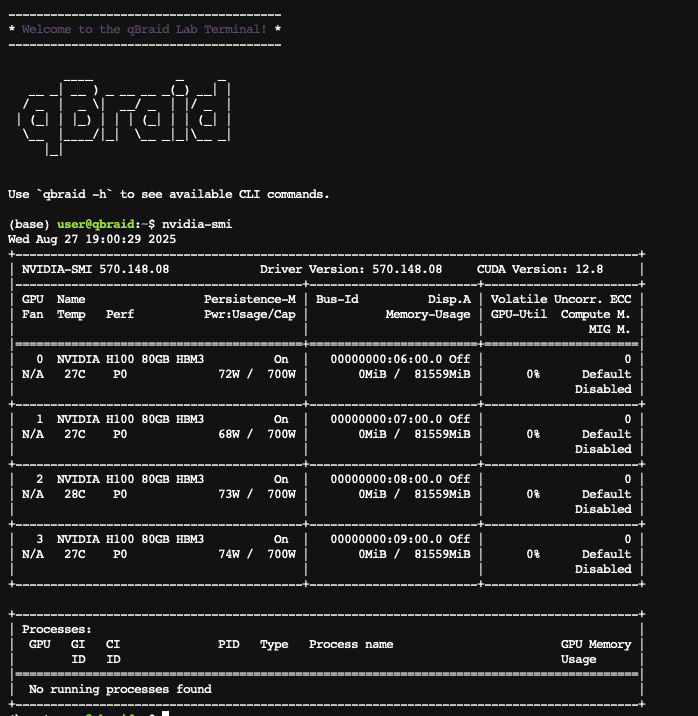Press Releases
2
Min read
qBraid wins NSF POSE grant to build open source ecosystem

Contents:
Author: Greg Wymer
by Chris Keshian, MIT delta v Program Manager
Quantum computing has massive implications, yet the current developer environment makes learning and collaboration difficult. qBraid, an MIT delta v startup, aims to increase accessibility to, and interoperability amongst, quantum computing resources.
Any user can log on to qBraid, deploy a quantum programming environment with their favorite languages, libraries, and tools, and start coding.
(skip this section if you already know!)
Quantum computing is the use of quantum-mechanical phenomena to generate and manipulate quantum bits, or qubits. Qubits can be subatomic particles such as electrons or photons, or sufficiently small structures such as superconducting loops on the nanometer scale.
Ordinary computers are made up of bits that exist in only one of two possible states (labelled 0 and 1), while qubits can occupy states which can be any kind of combination of 0 and 1 at the same time, an attribute called superposition. When measured, qubits will always return one of the classical states, with probability depending on how “close” the superposition is to either purely 0 or purely 1. Superpositions of states can also interfere either constructively, which make that outcome more likely, or destructively, which make that outcome less likely.
Furthermore, qubits can be generated in pairs of “entangled” qubits, meaning the pair exists in a single quantum state. This entangled nature means that changing the state of one qubit will instantaneously change the state of the other in a predictable way, even over long distances.
These two phenomena permit quantum computers to process information fundamentally more efficiently than ordinary computers with the same number of ordinary bits, resulting in the ability to solve computational problems at scales that are completely intractable otherwise. The degree of this advantage is dependent on the problem in question, and is truly revolutionary in scope.
Quantum computing makes certain computationally prohibitive tasks actually possible, which will have massive implications across numerous industries:<p
Currently, quantum algorithm development is siloed, meaning certain tools are not universally available and the code libraries are not connected. This makes collaboration and the ability to “stand on the shoulders of giants” difficult in this space, since developers cannot easily access and build on the work of others.
qBraid is building state-of-the-art tools in areas like quantum chemistry and cryptography, on a single cloud platform for writing quantum code that is inter-operable across quantum libraries and quantum hardware. The qBraid platform includes courses to train the next generation of quantum programmers and address an already evident shortage of quantum researchers and developers.
All of this lowers the barriers to entry for quantum developers, making it easier for engineers to go from zero experience to solving problems infeasible for the world’s best supercomputers.
qBraid is an all-in-one platform, accessible on the cloud. This means it has no local installation or compatibility concerns. Any user can log on to qBraid, deploy a quantum programming environment with their favorite languages, libraries, and tools, and start coding.
The platform is education-focused, with learning modules for new and experienced quantum developers, and provides access to a comprehensive set of interoperable tools<

Press Releases
2
Min read
qBraid wins NSF POSE grant to build open source ecosystem

Product
3 minutes
Min read
Supercharge your quantum workflows with GPUs on qBraid

Collaborations
3 minutes
Min read
qBraid has been selected by IBM to host their annual Qiskit Global Summer School for the second year in a row.

Collaborations
3 minutes
Min read
qBraid has been selected by IBM to host their annual Qiskit Global Summer School for the second year in a row.

Collaborations
5
Min read
As an early adopter of the NVIDIA GH200 Grace Hopper Superchip systems, qBraid provides unparalleled access to today’s most advanced computing technologies.

Collaborations
1
Min read
Explore the advantages of cloud-based quantum computing and how it is revolutionizing research and development across various industries

Collaborations
1
Min read
Discover how quantum computing is revolutionizing enterprises, from enhancing cybersecurity with quantum encryption to optimizing complex logistics and supply chain operations.

Collaborations
5
Min read
qBraid’s quantum computing platform adds access to 256 qubit neutral atom quantum computer, Aquila by QuEra.

Collaborations
5
Min read
qBraid and Quantum Algorithms Institute partner to accelerate the pace of quantum computing in British Columbia and beyond.

Collaborations
4
Min read
The qBraid platform will allow users to play with Pulser in a matter of a few minutes.

Hackathons
5
Min read
As part of QHack, qBraid is providing the best quantum developer notebook environment experience for challengers.

Hackathons
10
Min read
From October 21st to November 5th of 2022, qBraid hosted HAQS, one of the most popular quantum computing events of the year, where participants from around the world worked on solving a total of five quantum computing challenges during the two weeks of the event.

Hackathons
5
Min read
At this year's QCHack, participants attended a week filled with amazing talks, 1:1 sessions with academic and industry mentors, and a 24 hour hackathon hosted by Stanford, Yale and Berkeley.
-min.jpeg)
Hackathons
4
Min read
The potential of the field of quantum computing is so huge that everyone in the field cannot wait for all the promises that the field holds to become a reality.

Research
5
Min read
IEEE has awarded qBraid and its collaborators 1st place for the Best Paper Award in the Quantum Algorithm Track.

Research
1
Min read
qBraid's team used hybrid classical-quantum algorithms to determine the best flight path

Research
1
Min read
Learn how classical sampling methods, such as Markov Chain Monte Carlo, can estimate truncation errors in simulating bosons on quantum computers, aiding resource assessment and result validation for quantum simulations, including applications in two-dimensional lattice scalar field theory.

Press Releases
2
Min read
qBraid wins NSF POSE grant to build open source ecosystem

Press Releases
10
Min read
qBraid and NVIDIA CUDA-Q are removing the two biggest blockers to AI4Quantum research

Press Releases
8
Min read
Our first cohort of the qBraid Alliance, a partnership with student organizations at leading universities around the country.

Press Releases
5
Min read
Coming from IBM Quantum Lab? Learn how to start using qBraid Lab

Press Releases
10
Min read
The Bloch develops quantum technology solutions for society’s most pressing problems by accelerating industry adoption to drive research commercialization, catapulting US leadership in quantum information science and technology.

Press Releases
5
Min read
Our newest podcast series

Press Releases
5
Min read
qBraid will lead a team of researchers from MIT, UChicago, Argonne National Laboratory, and QuEra to develop quantum computing solutions for studying the interaction of metals and intrinsically disordered proteins.

Press Releases
Min read
OSU uses qBraid for accessing Intel Quantum SDK

Press Releases
5
Min read
qBraid provides agnostic connections to quantum computers and simulators thanks to Amazon Braket

Press Releases
10
Min read
Duality Quantum Accelerator Accepts Six Startups into Inaugural Cohort

Press Releases
1
Min read
Take the QuBes (Quantum Beginners) course to learn quantum computing.

Press Releases
5
Min read
qBraid aims to increase accessibility to, and interoperability amongst, quantum computing resources.

Product
3 minutes
Min read
Supercharge your quantum workflows with GPUs on qBraid
.png)
Product
5
Min read
We are pleased to have presented qBraid’s Platform-Agnostic Open-Source Tools at the Quantum Computing Devroom in FOSDEM 2025.

Product
5
Min read
Accelerating hybrid workflows using Pennylane's embedded simulators with NVIDIA GPUs on qBraid Lab.

Product
5
Min read
Here are 3 ways to install python packages on qBraid

Product
2
Min read
How to install Cirq v1.2.0 environment on qBraid Lab

Product
1
Min read
Let qBraid help you take your first step into the quantum world!

Product
1
Min read
Intel® Quantum SDK is generally available on qBraid Lab for Free with no installation necessary

Product
1
Min read
Dive into the intricate interplay of the Bernoulli line and the Bloch sphere, revealing profound geometric insights into quantum state dynamics.